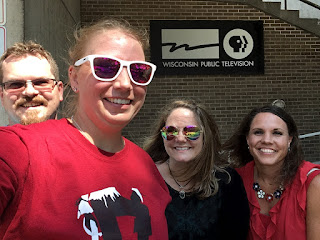APES: TED-KM A New (Passion Based) Form of Summative Assessment
Throughout my career as a student, and my first few years of teaching, I have found speaking activities to be one of the most challenging for students in terms of anxiety. That wasn't a surprise, but I felt that there was an opportunity to work on this in the science classroom. I am very passionate about interdisciplinary learning and crossing boundaries out of areas of comfort and truthfully that is how TED-KM came to be.
Selfishly, at EdCamp Wausau I proposed the topic of TED Talks as a new form of summative assessment, because it was something I was interested in doing in our classroom. That was close to one of the best ideas I had proposing it as a topic because it brought together a group of passionate educators that were willing to work through the nuts and bolts and create something so that I could implement something, tomorrow.
Students took the opportunity and really ran with it. I used a rubric for the assessment including parts of a rubric that they would experience in their ELA and speech courses. This would not only assess science content skills, but it would also assess presentation skills. Students got to choose their topic that they were most passionate about, based on all of the content that we covered in the course. Topics ranged from factory farming, to climate change, nutrition, and saving our coral reefs and seas.
This was not something that we could jump into without providing seminars on each part of the presentation. We provided seminars on TED Talks, breaking down and talking about the positives and negatives of some of the talks that we watched in class. We also talked about what it means to be engaging and passionate about a topic. Students brainstormed lists of the qualities of good presentations. We provided a seminar on citing your sources. Our class also talked about how to assemble presentations. It was decided that students were to leave words off of the slides, unless they had to do with figures and data. They were to talk to their slides that were in front of them. We also talked about the qualities of good presentations and took a look at the rubric components. In the future, I will again have students help to create the rubric. I might also allow students an opportunity to choose when they are assessed on the rubric components throughout the year. Our year ended up with these presentations as their summative assessement and it was truly evident how much students learned throughout the years. I look forward to offering this as an assessment opportunity in the future.
Selfishly, at EdCamp Wausau I proposed the topic of TED Talks as a new form of summative assessment, because it was something I was interested in doing in our classroom. That was close to one of the best ideas I had proposing it as a topic because it brought together a group of passionate educators that were willing to work through the nuts and bolts and create something so that I could implement something, tomorrow.
Students took the opportunity and really ran with it. I used a rubric for the assessment including parts of a rubric that they would experience in their ELA and speech courses. This would not only assess science content skills, but it would also assess presentation skills. Students got to choose their topic that they were most passionate about, based on all of the content that we covered in the course. Topics ranged from factory farming, to climate change, nutrition, and saving our coral reefs and seas.
This was not something that we could jump into without providing seminars on each part of the presentation. We provided seminars on TED Talks, breaking down and talking about the positives and negatives of some of the talks that we watched in class. We also talked about what it means to be engaging and passionate about a topic. Students brainstormed lists of the qualities of good presentations. We provided a seminar on citing your sources. Our class also talked about how to assemble presentations. It was decided that students were to leave words off of the slides, unless they had to do with figures and data. They were to talk to their slides that were in front of them. We also talked about the qualities of good presentations and took a look at the rubric components. In the future, I will again have students help to create the rubric. I might also allow students an opportunity to choose when they are assessed on the rubric components throughout the year. Our year ended up with these presentations as their summative assessement and it was truly evident how much students learned throughout the years. I look forward to offering this as an assessment opportunity in the future.



.JPG)
Comments
Post a Comment